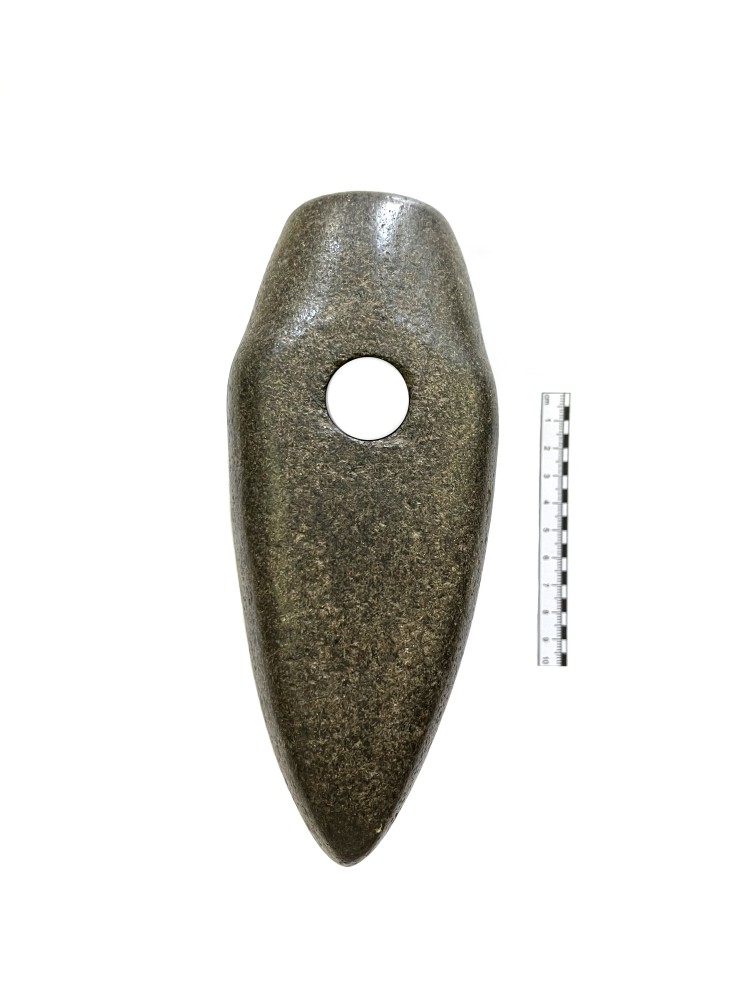#Exhibit of the Month
>>>

The artifact is a battle axe made from magmatic rock (diabase) of gray-brown color. It was accidentally discovered in 1966 within the territory of Aluniș village, Rîșcani district. Based on its morphological characteristics, the artifact can be attributed to the Catacomb culture (29th-22nd centuries BCE). The axe features a massive, elongated naviform body with slightly pronounced shoulders, a short and narrow edge that is flat and circular in cross-section. The blade is slightly curved. The hole was drilled in the maximum width of the object. It is circular in shape with a diameter of 2.2 cm. The surface of the artifact is meticulously polished, worked with great care, and shows no signs of damage or chipping. Dimensions: Length: 20.0 cm; Maximum width: 8.4 cm; Edge diameter: 5.0 cm; Blade width: 7.0 cm; Weight: 2.3 kg. Stone battle axes are characteristic of the Catacomb culture communities and are most often found as grave goods, deposited in tombs. Their presence in funerary complexes suggests a multifaceted functionality: weapons, social symbols, and ritual objects. Initially used as weapons, the axes became social symbols for their owners, later acquiring votive significance when deposited in tombs to serve the deceased in the afterlife. The social symbolic function of stone battle axes is indicated by the high-quality rocks used for their manufacture and the exceptionally meticulous craftsmanship. The large dimensions of the axe from Aluniș support this hypothesis and distinguish it from other examples. The discovery of stone battle axes outside a funerary complex may indicate their votive deposition. It is difficult to imagine that these exceptionally well-crafted pieces, made from high-quality rocks transported over great distances, could have been abandoned or lost accidentally. It is far more likely that they were deposited for magical-religious purposes, a possibility that may also apply to the stone axe discovered at Aluniș.

Virtual Tour
|

|
|
|
 |
  Exhibitions Exhibitions
"Works of Architect Valentin Voitsekhovsky"
August 9 – September 9, 2012
The exhibition is dedicated to the commemoration of 35 years from the death of architect V. Voitsekhovsky (1909-1977); it is a tribute to this outstanding person who has greatly contributed to the reconstruction of postwar Chisinau and the urban construction in the country. Based on his projects in the Chisinau there were designed about 100 buildings, including the "Patria" Cinema (1951), buildings of the first residential district of Botanica (1952-1962), the building of the Ministry of Food Industry (1953), "N. Testemițeanu" Medical University (1956-1962), buildings from the 4 th residential district of Riscani (1961), "S. Lunchevici" State Philharmonic (1962), a number of residential buildings on Stefan cel Mare Boulevard in Chisinau, and many residential buildings, schools, cinemas at the towns of Balti and Soroca. In his work V. Voitsekhovsky used motifs of Moldavian folk architecture and local materials. He used glazed ceramic elements for decoration of facades in accordance with the traditions of Byzantine architecture. V. Voitsekhovsky was at the forefront of the Moldavian Soviet architecture, one of the few founders of the national architectural school. The exhibition presents photographs and original documents from the museum and private collections. Valuable is the collection of the National Museum of Archaeology and History of Moldova, which reflects the activities of the Andronache (Andrunakevich) - Stadnițki family, revealing biography of the architect wife - Tatiana, well-known pianist and teacher at the Chisinau State Conservatoire, a daughter of renowned Bessarabian pianist Antonina Stadnițki - Andronache. An important part of the exhibition presents the development of Soroca, the hometown of the architect V. Voitsekhovsky. Among the authentic materials (projects, models) there is shown an original project - the former Sovnarkhoz building (now Ministry of Industry), situated on Stefan cel Mare Boulevard. For many years this project has been preserved in A. V. Şciusev's Memorial Museum and currently is in the possession of the National Museum of Archaeology and History of Moldova. This work of the architect is the core of the exhibition.
|
 |
|
|
 |
|
#Exhibit of the Month

The artifact is a battle axe made from magmatic rock (diabase) of gray-brown color. It was accidentally discovered in 1966 within the territory of Aluniș village, Rîșcani district. Based on its morphological characteristics, the artifact can be attributed to the Catacomb culture (29th-22nd centuries BCE)...
Read More >>
The National Museum of History of Moldova takes place among the most significant museum institutions of the Republic of Moldova, in terms of both its collection and scientific reputation.
©2006-2025 National Museum of History of Moldova
 31 August 1989 St., 121 A, MD 2012, Chisinau, Republic of Moldova
Phones: 31 August 1989 St., 121 A, MD 2012, Chisinau, Republic of Moldova
Phones:
Secretariat: +373 (22) 24-43-25
Department of Public Relations and Museum Education: +373 (22) 24-04-26
Fax: +373 (22) 24-43-69
E-mail: office@nationalmuseum.md
Technical Support: info@nationalmuseum.md
Web site administration and maintenance: Andrei EMILCIUC
|
| |
